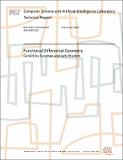| dc.contributor.author | Sussman, Gerald Jay | |
| dc.contributor.author | Wisdom, Jack | |
| dc.date.accessioned | 2005-12-22T02:21:07Z | |
| dc.date.available | 2005-12-22T02:21:07Z | |
| dc.date.issued | 2005-02-02 | |
| dc.identifier.other | MIT-CSAIL-TR-2005-007 | |
| dc.identifier.other | AIM-2005-003 | |
| dc.identifier.uri | http://hdl.handle.net/1721.1/30520 | |
| dc.description.abstract | Differential geometry is deceptively simple. It is surprisingly easyto get the right answer with unclear and informal symbol manipulation.To address this problem we use computer programs to communicate aprecise understanding of the computations in differential geometry.Expressing the methods of differential geometry in a computer languageforces them to be unambiguous and computationally effective. The taskof formulating a method as a computer-executable program and debuggingthat program is a powerful exercise in the learning process. Also,once formalized procedurally, a mathematical idea becomes a tool thatcan be used directly to compute results. | |
| dc.format.extent | 77 p. | |
| dc.format.extent | 38556269 bytes | |
| dc.format.extent | 1665777 bytes | |
| dc.format.mimetype | application/postscript | |
| dc.format.mimetype | application/pdf | |
| dc.language.iso | en_US | |
| dc.relation.ispartofseries | Massachusetts Institute of Technology Computer Science and Artificial Intelligence Laboratory | |
| dc.subject | AI | |
| dc.subject | Scheme differential geometry calculus manifolds | |
| dc.title | Functional Differential Geometry | |
